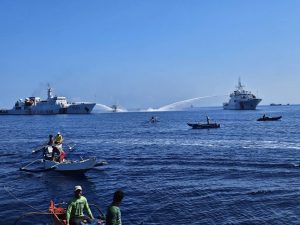China’s government has announced the baselines of its territorial sea adjacent to Scarborough Shoal, a contested reef in the South China Sea, in a bid to strengthen its expansive claims over the vital waterway.
On Sunday, China published a set of geographic coordinates for 16 base points around the triangular reef, which it refers to as Huangyan Dao. A Chinese Foreign Ministry spokesperson said in a statement that the decision to delimit and announce the baselines around Huangyan Dao, as Beijing refers to the shoal, was “ a natural step by the Chinese government to lawfully strengthen marine management and is consistent with international law and common practices.”
It added, “Huangyan Dao has always been China’s territory.”
According to the U.N. Convention on the Law of the Sea (UNCLOS), a baseline is a line that runs along the coast of a country or an island, from which the limits of a state’s territorial sea and certain other maritime zones of jurisdiction are measured. These include exclusive economic zones (EEZs), 200-nautical-mile areas in which a state enjoys exclusive access to natural resources such as fisheries and deposits of oil and gas.
Also, on Sunday, China’s Ministry of Natural Resources and Ministry of Civil Affairs announced the formal naming of 64 islands and reefs in the South China Sea, providing the precise coordinates of each as well as its name in both Chinese characters and pinyin transliteration. Most of these features are located in the Spratly Islands, which are also claimed, in whole or in part, by the Philippines, Malaysia, Vietnam, Brunei, and Taiwan. Among the newly named features were several near Second Thomas Shoal and Sabina Shoal, two features in the Spratly Islands that have recently been the subject of tense stand-offs between the Chinese and Philippine coast guards.
The past few years have also seen tensions over Scarborough Shoal, a triangular barrier of reefs about 120 nautical miles (222 kilometers) west of Luzon, the northernmost Philippine island. The shoal lies within the Philippines’ EEZ, but has been under Chinese control since a protracted stand-off between the two countries in 2012. Recent tensions have focused on Chinese efforts to prevent Filipino fishermen from entering the shoal’s internal lagoon.
In 2016, a U.N. arbitration tribunal in The Hague ruled that China’s “nine-dash line” claim was invalid under UNCLOS, and that it had no legal claim to the features in the South China Sea, including Scarborough Shoal. The tribunal also classified the shoal as a rock, not an island. This means that even if the shoal is entitled to a 12-nautical-mile territorial sea, it cannot generate an EEZ of its own. Instead, the shoal was recognized as part of the EEZ and continental shelf of the Philippines, which refers to it as Bajo de Masinloc. China has rejected the arbitral ruling.
The Chinese announcement, the first such announcement of baselines within the Philippines’ EEZ, is a clear response to Philippine President Ferdinand Marcos Jr.’s enactment on Friday of two new pieces of legislation aimed at strengthening Manila’s South China Sea claims. As I noted yesterday, the Philippine Archipelagic Sea Lanes Act establishes a system through which foreign vessels and aircraft can exercise the right of passage through Philippine waters. The Philippine Maritime Zones Act seeks to set clear definitions for the Philippines’ maritime rights by creating routes over its waters and airspace. Both seek to align Philippine law with UNCLOS.
China’s Ministry of Foreign Affairs responded by summoning the Philippine ambassador to lodge a “stern protest” against the legislation. According to a post on Yuyuan Tantian, a social media channel affiliated with state broadcaster CCTV, the baselines for Scarborough Shoal were announced as a “direct” response to the enactment of the Philippine laws, The South China Morning Post reported.
“The reason we hadn’t published it earlier is that China has consistently taken a rational, restrained and responsible approach to handling maritime issues with neighboring countries,” the post said.
In its Sunday statement, the Chinese Foreign Ministry in Beijing said that the passage of the laws “aims to further solidify the illegal arbitral award on the South China Sea” and to “illegally” include Scarborough Shoal and the Spratly Islands in its maritime zones. It said that China will “do everything necessary in accordance with law to firmly defend its territorial sovereignty and maritime rights and interests.”
Beijing’s administrative escalation is the latest in a stepwise series of moves that have increased tensions between China and the Philippines, and is likely to lead to a further intensification of the Chinese security presence around Scarborough Shoal and other disputed features. As the South China Post reported, the China Coast Guard also issued a statement on Sunday, saying that its vessels would increase their patrols over Scarborough Shoal in order to “firmly uphold order, protect the local ecosystem and biological resources and safeguard national territorial sovereignty and maritime rights.”

































